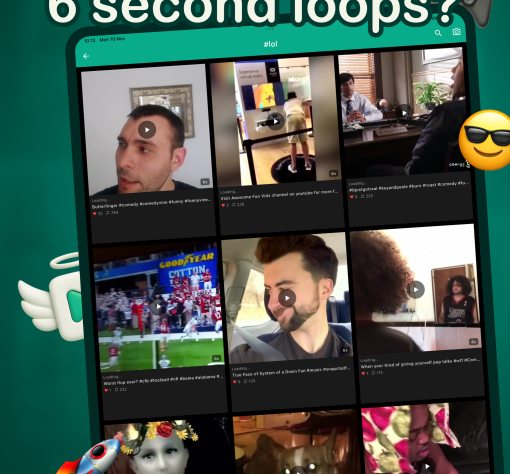With the rise of generative AI content in social applications, a new initiative aims to revive Vine’s six-second looping videos, backed by Twitter co-founder Jack Dorsey. Launching on Thursday, a fresh app named diVine will provide access to over 100,000 archived Vine videos that have been retrieved from a prior backup created before Vine’s closure.
The app will not only serve as a nostalgic experience but will also enable users to create profiles and upload their own new Vine videos. However, in contrast to typical social media platforms, where AI-generated content is frequently misrepresented, diVine will identify suspected generative AI content and stop it from being uploaded.

The establishment of diVine was funded by Jack Dorsey’s nonprofit organization “and Other Stuff,” which was created in May 2025. This initiative is dedicated to supporting experimental open-source projects and tools that could reshape the social media environment.
In order to develop diVine, Evan Henshaw-Plath, a former Twitter employee and member of “and Other Stuff,” delved into the Vine archive. After Twitter revealed its decision to close down the short video platform in 2016, a group known as the Archive Team undertook the task of backing up its videos. This community archiving effort is independent of Archive.org and instead represents a collective endeavor to preserve websites that are at risk of disappearing.
Regrettably, the group had preserved Vine’s content in substantial, 40-50 GB binary files, making it inaccessible to anyone hoping to view old Vine videos easily. Upon realizing the existence of the archive, Henshaw-Plath (who prefers the name Rabble) was motivated to explore the possibility of extracting older Vine content to create a mobile app resembling Vine.

“Essentially, I thought, can we create something that’s somewhat nostalgic?” he shared with TechCrunch. “Can we create an experience that takes us back, enabling us to revisit those past moments while also allowing for a version of social media where you can have some control over your algorithms, or choose who to follow, leading to a personalized feed, with the assurance that it’s a real person behind the video?”
Rabble dedicated several months to crafting big data scripts and unraveling how the files functioned, ultimately reconstructing them alongside the details of the previous Vine users and their interactions with the videos, such as view counts and a set of original comments.
Techcrunch event
San Francisco
|
October 13-15, 2026
“I couldn’t extract all the videos, but I managed to recover a significant number, essentially reconstructing these Vines and their creators, and providing each user with a new profile [on this open network],” he claimed.
Rabble believes the app encompasses a “substantial portion” of the most beloved Vine videos, though it lacks numerous lesser-known ones. He mentioned, for example, that countless K-pop-related videos were never archived.

“We have approximately 150,000 to 200,000 videos from around 60,000 creators,” he mentioned, noting that initially, Vine had several million users and a much larger pool of creators.
Vine creators retain the copyright to their content and can make a DMCA takedown request through diVine if they wish to have their videos removed. They can also verify their account ownership by demonstrating access to the social media accounts originally listed in their Vine bio. (This verification process is not automated, potentially causing delays if many creators attempt to process requests simultaneously.)
Once they reclaim their account, they also have the option to upload new videos or share any old content that the restoration overlooked.
To confirm that new video uploads are made by humans, Rabble is implementing technologies from the Guardian Project, a human rights nonprofit that helps ascertain that content is genuinely recorded on smartphones, along with additional checks.

Moreover, due to its construction on Nostr, a decentralized protocol that Dorsey supports, and its open-source nature, developers are empowered to design and create their own applications and operate independent hosts, relays, and media servers.
“Nostr — the open-source protocol behind diVine — is enabling developers to produce a new wave of applications that do not require venture capital support, harmful business models, or extensive engineering teams,” Jack Dorsey stated in a released comment. “The motivation behind my investment in the non-profit, and Other Stuff, is to enable innovative engineers like Rabble to explore what’s feasible in this new realm, by utilizing permissionless protocols that cannot be shut down arbitrarily by corporate entities.”
Elon Musk, the current owner of Twitter/X, has also committed to reinstating Vine, having shared in August that the company found the previous video archive. So far, however, nothing has been launched to the public. The diVine initiative, supported by Dorsey, maintains that because the content is sourced from an online archive and the creators retain their copyrights, its use is considered fair use.

Rabble is confident there is a market for this type of non-AI-driven social interaction, despite the increasing favor for generative AI content and the widespread use of applications like OpenAI’s Sora and Meta AI.
“Companies observe the engagement with AI and wrongly conclude that people desire it,” Rabble clarified. “They misunderstand the situation — yes, people interact with it; yes, we utilize these technologies — but concurrently, we seek control over our lives and social interactions. Thus, there’s a longing for the initial Web 2.0 period, for the blogging phase, and for the era that birthed podcasting, characterized by community building rather than merely playing the algorithm,” he added.
DiVine is accessible on both iOS and Android at diVine.video.

